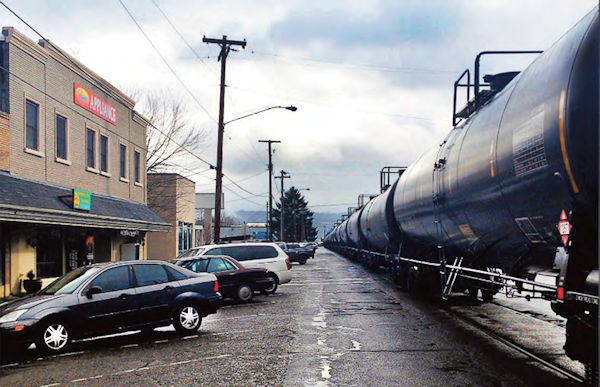SEJournal Online is the digital news magazine of the Society of Environmental Journalists. Learn more about SEJournal Online, including submission, subscription and advertising information.
Inside Story
Competition is fierce to win any honor in SEJ’s Awards for Reporting on the Environment. But Rob Davis, of The Oregonian’s investigative team, won not one, but two first-place awards in the 14th annual contest this year. Davis’ work “embodies the spirit of beat reporting … his reporting shines a light on local injustices, holds decision makers accountable,” judges wrote in awarding him the highest prize for Outstanding Beat Reporting, Small Market. Davis also won first place in the Kevin Carmody Award for Outstanding In-depth Reporting, Small Market for his work on explosive oil trains that judges called “investigative reporting at its finest.” The Maryland native was previously an investigative reporter covering the environment for Voice of San Diego, the online nonprofit. He has also written for The New York Times and served as a board member for the Society of Environmental Journalists. “Inside Story” editor Beth Daley interviewed Davis recently.
 |
| In 2013, 110 trains carried 252 million gallons of crude oil directly through Rainier, Ore., a rural town on the Columbia River. Photo by Sloan Nelson |
SEJournal: How did the oil train stories come about?
Rob Davis: When a train hauling crude oil through Quebec exploded and killed 47 people in July 2013, backers of a proposed oil train terminal near Portland characterized it as isolated. Couldn’t happen here, they said. Then another train exploded, then a third. That got my attention. Initial reader response was overwhelming — thousands live along rail lines here. I used their curiosity to help guide my run-and-gun investigation.
SEJournal: What was the hardest piece to report, why and how did you overcome it?
Davis: It was challenging just to find out where oil was moving by rail and in what volume. Railroads and state safety regulators knew but refused to say. I successfully petitioned Oregon’s attorney general to force the relevant reports’ disclosure. Regulators said they would stop collecting the data because I’d made it public. They reversed themselves as soon as we printed that news.
SEJournal: You often rely heavily on data/documents — how did you know what to ask for and when?
Davis: Whenever I launch into an investigation, I always look for someone who knows the terrain and can guide me. Early on in my oil train investigation, I connected with a former state rail safety inspector who was exceedingly generous with his time and counsel. He helped me figure out what to ask for — and let me know I was being lied to when bureaucrats told me it didn’t exist.
SEJournal: In your school bus story about children breathing unhealthy fumes from old buses, how did you find the oldest bus, No. 35, a 1981 one?
 |
| Rob Davis, The Oregonian |
Davis: I’d heard that California was stripping pollution controls out of old school buses it was sending to Oregon. I wasn’t able to substantiate that. But while trying, I requested from the Oregon Department of Education a database of every school bus in the state — by model year and school district. Turns out, one existed. It showed that thousands of old dirty diesel buses (pre-2007) were still operating here, endangering the health of tens of thousands of children.
SEJournal: What are your three top tips to journalists to dig deeper into environmental stories?
Davis: One, get beyond “he said, she said.” If an environmental advocate claims something bad is happening, do the research and get the documents to authoritatively prove it yourself. Two, dive deepest on stories where you’re going to be able to prove harm is occurring and there’s someone who can be held accountable. Three, when you find harm, humanize it. On an editor’s suggestion, I spent a week trying to find an Oregon school kid who faces a higher chance of getting cancer because he rides an unnecessarily high-polluting diesel bus each day. That yielded quotes like this: “He’s so little. He’s only 4 years old. I don’t want my son being one of those kids that develops cancer.”
SEJournal: Your stories, such as the one on the disappearing Lake Abert, draw on history, great imagery and voices. What is the most important element in an explanatory story like that?
Davis: To get readers to care about a far-flung, forgotten spot, they need to be immersed in its sense of place, its ethos. They need to see and experience its essence through the page. Our web presentation gave me the tools to help bring the place to life.
SEJournal: Do you always take your own photos and what tips do you have to get the best shots out on a story?
Davis: I love photography, so I try to shoot as many of my own stories as I can. The most important tip for a reporter who’s also shooting: Slow down. When I’m juggling an iPhone, a DSLR, a pen and notebook, I consciously shift into a photo-taking mode, suppressing the inclination to fire off a quick snapshot so I can pick my notebook back up.
“Inside Story” editor Beth Daley is a reporter and director of partnerships at the New England Center for Investigative Reporting, a nonprofit newsroom based at Boston University and affiliated with WGBH News.
* From the quarterly newsletter SEJournal, Winter 2015/2016. Each new issue of SEJournal is available to members and subscribers only; find subscription information here or learn how to join SEJ. Past issues are archived for the public here.











 Advertisement
Advertisement 



